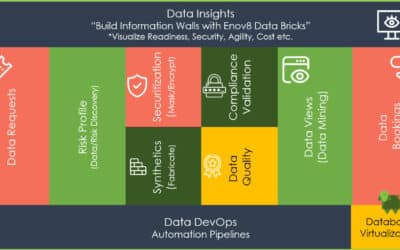
The hierarchy of SAFe (Scaled Agile Framework) Explained
DEC, 2022
by Jane Temov.
Jane Temov is an IT Environments Evangelist at Enov8, specializing in IT and Test Environment Management, Test Data Management, Data Security, Disaster Recovery, Release Management, Service Resilience, Configuration Management, DevOps, and Infrastructure/Cloud Migration. Jane is passionate about helping organizations optimize their IT environments for maximum efficiency.
The Scaled Agile Framework (SAFe) is a comprehensive set of principles and practices designed to help organizations adopt agile methods on an enterprise level. It provides a set of guidelines and best practices that enable large-scale product development with agility. At its core, SAFe has a hierarchical structure, which assigns different roles and responsibilities in order to facilitate efficient and effective product development.
Enov8 Enterprise Release Manager
*Innovate with Enov8
Streamline delivery of IT change through embracing “Scaled Agile” best practice.
In this article, we will explore the hierarchy of SAFe in detail, looking at each role and how they fit into the framework. Through this exploration, readers will gain a better understanding of SAFe’s hierarchical structure and how it works to help organizations successfully adopt agile methods.
An Overview of the SAFe Hierarchy
The SAFe hierarchy consists of seven levels of hierarchy, each of which is designed to manage a different aspect of the development process. From highest to lowest, these levels are:
- Portfolio Level: The highest level of hierarchy in SAFe, representing a portfolio of solutions, products, and services. The Portfolio level is responsible for defining the overall business strategy, allocating resources, and managing the overall value stream.
- Solution Level: The level below Portfolio, representing large, complex solutions that require multiple Agile Release Trains (ARTs) to deliver. The Solution level is responsible for coordinating the efforts of multiple ARTs to deliver a complete solution.
- Agile Release Train (ART) Level: A long-lived, cross-functional team that delivers value to the customer through the delivery of solutions. The ART level is responsible for planning, executing, and delivering value to the customer in the form of fully functional solutions.
- Program Increment (PI) Level: A timebox of 8-12 weeks during which the ART delivers a fully integrated and tested increment of working solutions. The PI level is responsible for defining and managing the scope of the ART’s work, and ensuring that the ART delivers on its commitments.
- Feature Level: A collection of stories that together deliver a larger, more significant capability. The Feature level is responsible for defining the features that the ART will deliver during the PI, and ensuring that the features are delivered on time and within budget.
- Story Level: A small, independent slice of a feature that delivers value to the customer. The Story level is responsible for defining the specific tasks that the development team will work on to deliver the feature.
- Work Item Level: A smaller work item that represents a specific task that needs to be completed to finish a story. Work Items are the smallest unit of work in SAFe, and they are used to track progress, estimate work, and plan sprints.
Enov8 – SAFE Hierarchy – Diagram
The Levels of SAFe Explained
Portfolio Level of SAFe
The Portfolio level of SAFe is focused on strategic initiatives that are managed by the enterprise. This level enables organizations to identify their overall goals and objectives, create plans to achieve them, and execute strategies for achieving those goals. It provides an environment where programs and projects can be coordinated across value streams, enabling seamless implementation of portfolio strategies.
Solution Level of SAFe
The Solution level of SAFe is the next level in the framework. It is used to manage large, complex solutions that require multiple Agile Release Trains (ARTs) to deliver. At this level, teams are able to develop a set of integrated capabilities across multiple ARTs in order to create an end-to-end solution that meets customer requirements.
Agile Release Train (ART) Level of SAFe
The Agile Release Train (ART) level of the Scaled Agile Framework (SAFe) is where the long-term value delivery begins. This level typically consists of a cross-functional team, typically composed of 8 to 12 agile teams, that works over multiple program increments and provides ongoing development toward meeting customer needs. The ART level is responsible for setting priorities, managing risk and dependencies, providing coordination between agile teams, and ensuring alignment with the larger organizational strategy.
Examples of types of work managed at this level include developing large solutions or initiatives that need to be broken down into smaller tasks for several agile teams to execute on in successive iterations; integrating components from other teams across programs; and working with stakeholders to ensure progress is in alignment with business goals. The ART level is where the organization’s vision of what needs to be created and delivered can be translated into concrete deliverables that will ultimately benefit customers.
At the Agile Release Train (ART) level, SAFe emphasizes agile values such as collaboration, customer focus, and respect for people. This encourages teams to remain flexible and responsive when working together across multiple program increments – allowing for a more adaptive approach to value delivery over time. By delivering solutions in small increments via the agile teams, organizations using SAFe at this level are able to quickly respond to customer demands and make adjustments if needed along the way.
Program Increment (PI) Level of SAFe
The Program Increment (PI) level is the next level in SAFe. It focuses on large initiatives that span multiple releases and often involve multiple teams or departments. At this level, a program roadmap is developed to align releases with desired business objectives. The PI also serves as a timebox for Portfolio Epics, Features, and value streams to be completed across all Agile Release Trains (ARTs).
Examples of types of features that might be managed at this PI level include IT projects such as large infrastructure upgrades or organizational change initiatives like implementing a new workflow system. In addition, strategic programs such as launching new products or services may begin at the PI level.
At the end of each Program Increment (PI), a review is conducted to assess progress and identify any areas for improvement. This includes an examination of how well each Agile Release Train (ART) performed against the program roadmap, including release plan targets. The PI level also provides a forum for teams to share best practices and lessons learned with each other.
Feature Level of SAFe
The Feature level of the Scaled Agile Framework (SAFe) is designed to manage larger, more significant capabilities that are made up of a collection of related stories. Features are generally larger in scope than individual user stories, and they provide high-level overarching objectives that need to be fulfilled. A feature can be broken down into multiple work items so that it can fit within an iteration or sprint time frame.
Examples of features could include a new product feature such as a customer onboarding process, building a tool for data analysis, or creating an authentication system with multi-factor authentication. These features typically require a combination of tasks and resources to complete them and have measurable business goals associated with them. At this stage, features are split into smaller stories that are worked on in parallel. This helps to ensure the feature is completed within a specific timeframe and budget.
Tip: Sometimes you may hear the word Epic & Feature used interchangeably. However there is a difference. An Epic is typically a larger user story that is too large to be completed in a single sprint, and is therefore broken down into smaller, more specific user stories called Features. Or to put it another way: “an EPIC is a set of Features”.
Story Level of SAFe
The Story level of the Scaled Agile Framework (SAFe) is designed to manage a collection of individual work items that together deliver a specific functionality or capability. At this level, user stories are created and refined to provide clarity on what needs to be built and how it should operate. These stories are then broken down into tasks and assigned to team members for completion.
Examples of types of stories that might be managed at this level include features such as creating an order processing system, building a web page form with various input fields, or integrating a third-party API. By breaking these larger features down into smaller stories, teams are able to quickly identify which tasks need to be completed in order to make progress on the feature. This helps to ensure that the feature is built effectively and efficiently, while also providing visibility into progress at all times.
Work Item Level of SAFe
At the lowest level, SAFe has the Work Item (aka Tasks). This is a unit of work or an actionable item that needs to be completed in order for the project to move forward. It can also represent any type of working package such as a feature, user story, bug fix, etc. All such items are managed within a system like JIRA or Trello and tracked until completion.
Each Work Item is assigned to an Iteration (or sprint) which allows it to be worked on by one or more teams. The Iteration should include all tasks necessary for completing the work item so that progress can be effectively monitored and measured. In addition, this allows team members to collaborate together in tackling larger items as well as ensuring that all tasks required for completion are identified.
Once the Work Item has been completed, it will be part of a larger Feature or Epic which is managed at the Program Level. This allows teams to see their progress within a particular program and how their work fits into the bigger picture. The feature/epic can then be tracked, allowing teams to measure velocity, resource utilization and any other metrics necessary for successful project delivery.
Conclusion
In conclusion, the Scaled Agile Framework (SAFe) is a comprehensive model for managing software and product development projects using an iterative approach. By breaking down larger features into smaller stories and tasks, teams can efficiently coordinate their efforts while providing visibility into progress at all times. This allows teams to quickly identify which tasks need to be completed in order to finish the project on time and within budget. In addition, it provides a structure for tracking progress and measuring resource utilization, velocity and other metrics necessary for successful project delivery. By following the SAFe methodology, teams can ensure that they are able to effectively manage large scale projects with ease.
Other SAFe Reading
Some more SAFe articles you can read over a coffee:
Enov8 Blog: The Agile Release Train Explained
Enov8 Blog: What is Release Management – An ERM & SAFe Perspective
Enov8 Blog: What is the Role of a Release Train Engineer?
Relevant Articles
8 DevOps Anti-Patterns to Avoid
It’s the normal case with software buzzwords that people focus so much on what something is that they forget what it is not. DevOps is no exception. To truly embrace DevOps and cherish what it is, it’s important to comprehend what it isn’t. A plethora...
An Introduction to Application Rationalization
In today's fast-paced digital landscape, organizations often find themselves grappling with a sprawling array of applications. While these applications are crucial for various business operations, the lack of a structured approach to managing them can lead to...
What Makes a Great Test Data Management Tool
What Makes a Great Test Data Management Tool? In today's fast-paced IT landscape, having a robust Test Data Management (TDM) tool is crucial for ensuring quality, compliance, and efficiency in software development and testing. At Enov8, we pride ourselves on providing...
The Top Application Portfolio Management Tools
Managing an application portfolio is essential for organizations aiming to optimize their IT operations, reduce costs, and enhance overall efficiency. Application Portfolio Management (APM) tools are designed to help organizations achieve these goals by providing a...
What Is a Test Data Manager?
Testing is a critical aspect of software development, and it requires the use of appropriate test data to ensure that the software performs optimally. Test data management (TDM) is the process of creating, storing, and managing test data to ensure its quality,...
Sprint Scheduling: A Guide to Your Agile Calendar
Agile sprints can be a powerful, productive and collaborative event if managed properly. However, when neglected or set up incorrectly they risk becoming chaotic and inefficient. Crafting an effective schedule for your sprint is essential to ensure the success of your...











